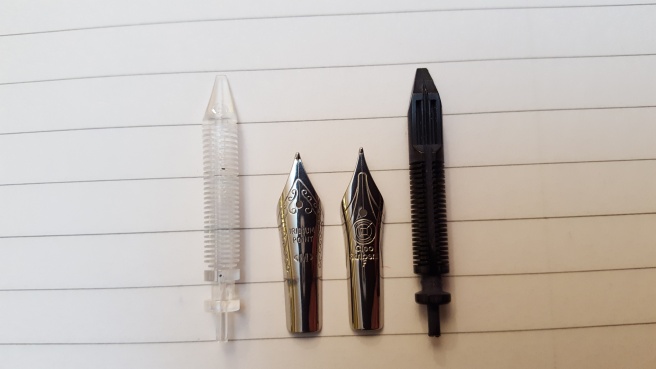
Happy Mothers’ Day, from London. Also, the clocks went forward today. Spring is officially here and we are now in British Summer Time and enjoying lighter evenings.
Today’s splash of colour comes from a recent visit to my local Paperchase stationery shop. As well as selling Cross, Kaweco, Lamy and Parker fountain pens they have a few of their own brand cartridge pens. I have tried three different models since July 2016, costing up to £6.00. This current blue demonstrator model is just £2.50 including three blue cartridges.
For this, you get a lightweight, plastic pen with a snap-on cap. The plastic pocket clip is quite springy and functional. The cap posts securely, giving a posted length of 150mm. The steel nib has no markings or breather hole but does have tipping material. It also has a wick between the nib and feed to help with ink supply. I would describe the nib as a medium.
The section is clear plastic and through this you can see the feed which is of a light blue plastic.
The pen takes a standard international cartridge but does not have room for a spare. The barrel has a hole at the end and so unlike the Platinum Preppy, this pen could not be converted to an eye-dropper fill.
Inking it up for the first time, it took a while and a bit of shaking before ink reached the nib but once it did, the writing experience was surprisingly smooth and I had no complaints about the ink flow. In fact it wrote with hardly any pressure. Do not expect a flex nib but you can get a little bit of line width variation, between sideways strokes with no pressure and downward strokes with some pressure.

The pen also does reasonably well at starting up again after a few days of non-use, despite the absence of an inner cap.
At this price, it seems unfair to find fault but there is a sharp-edged step from the barrel down to the section which is rather uncomfortable, just where most people would grip the pen. Perhaps this was necessary in order to form the seal between the barrel and the snap-on cap but the comfort would be much improved if the moulded barrel could have a smooth edge.
Other than that, it is a colourful, handy and satisfactory little pen. I found that Paperchase also sells cute re-sealable bags of 20 coloured ink cartridges for £1.50 (as well as all black or all blue options) and so for a grand total of £4.00 you would be able to get by for a few months if you suddenly found yourself separated from any other writing implements. More likely perhaps, if you arrived in town and found that you had forgotten your preferred fountain pen, then a quick visit to Paperchase would get you back up and running for a minimal outlay.

For accuracy, I should say that the coloured ink pack did not include blues, but there were three included with the pen. There were actually two more greens in the pack of 20, but instead I used the remaining blues for the rainbow.
I have not yet tried all the coloured inks. What I have learned though, is that “standard international cartridges” means standard in size and not ink quality and so if you have a preferred brand of ink cartridge of the same size, you may prefer to use an ink that you know. However, at just seven and a half pence per cartridge, you cannot really go wrong with these and there is a certain pleasure to be had from experiencing such a modestly priced combination of pen and ink.








 My liking for notebooks goes back to childhood when it was a treat to visit Arthur Birds, our local independent stationer and book seller in Ickenham, a villagey suburb on the outskirts of London. Then, as now, I appreciated good quality and for a notebook, that included having stitched binding so that you could open the book flat without risk of the pages breaking loose.
My liking for notebooks goes back to childhood when it was a treat to visit Arthur Birds, our local independent stationer and book seller in Ickenham, a villagey suburb on the outskirts of London. Then, as now, I appreciated good quality and for a notebook, that included having stitched binding so that you could open the book flat without risk of the pages breaking loose.


